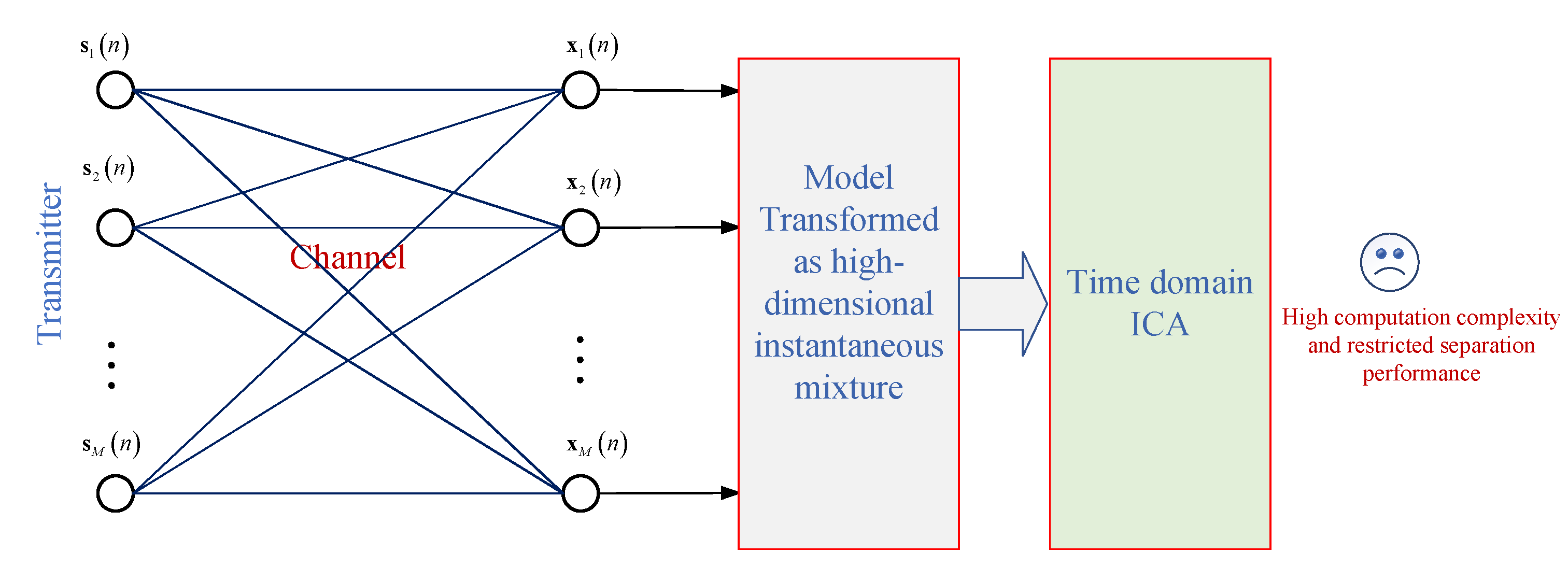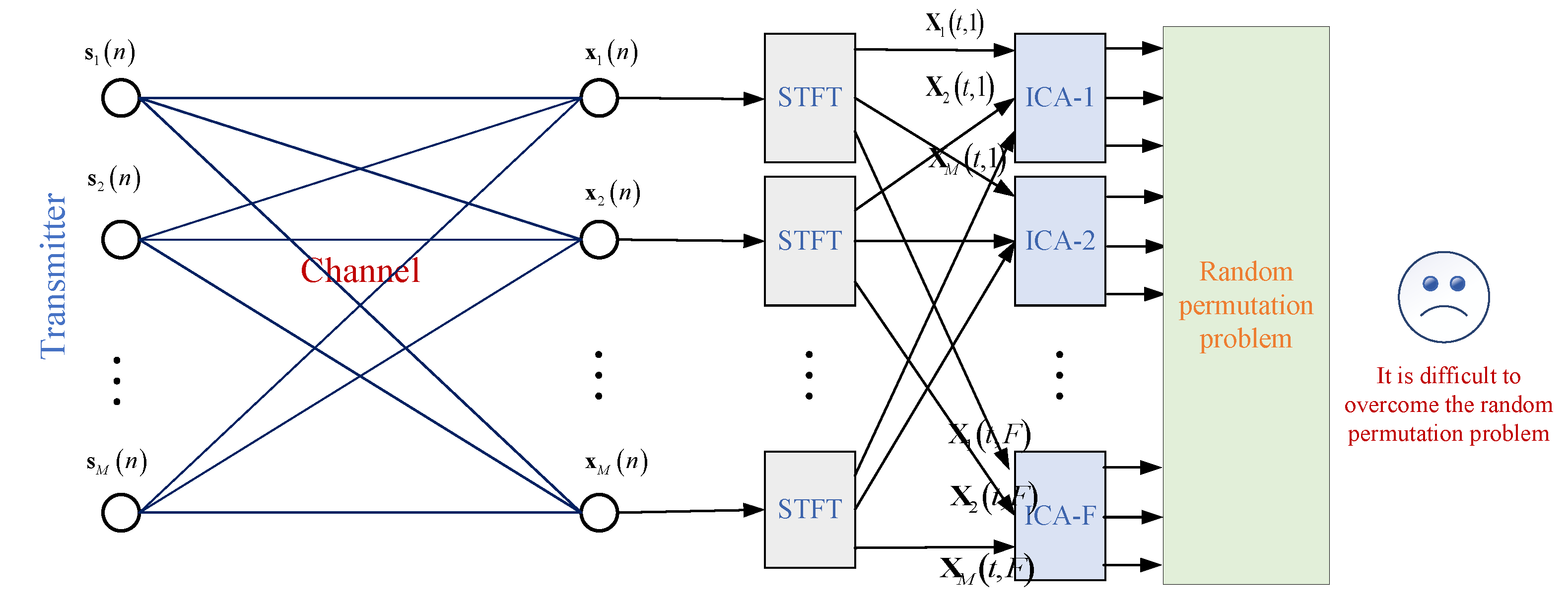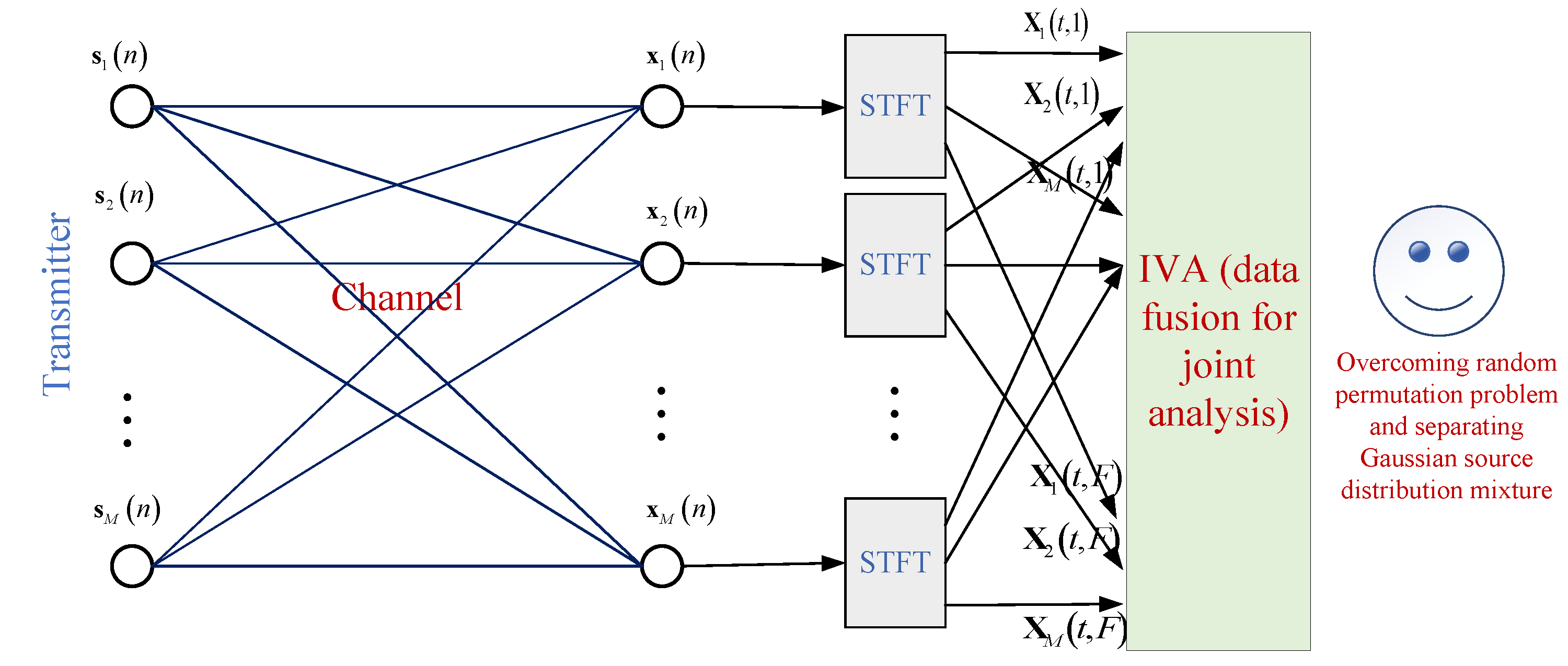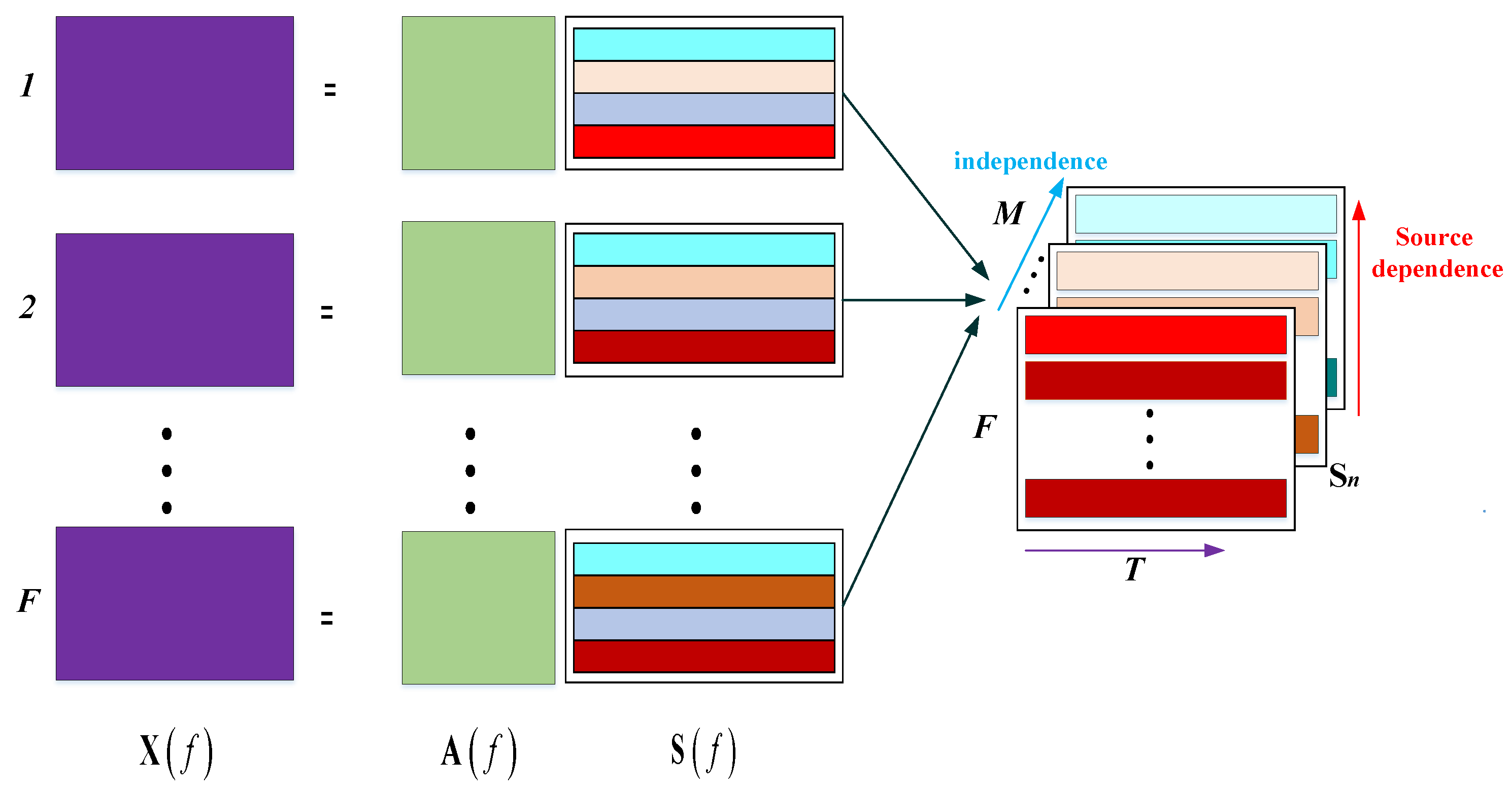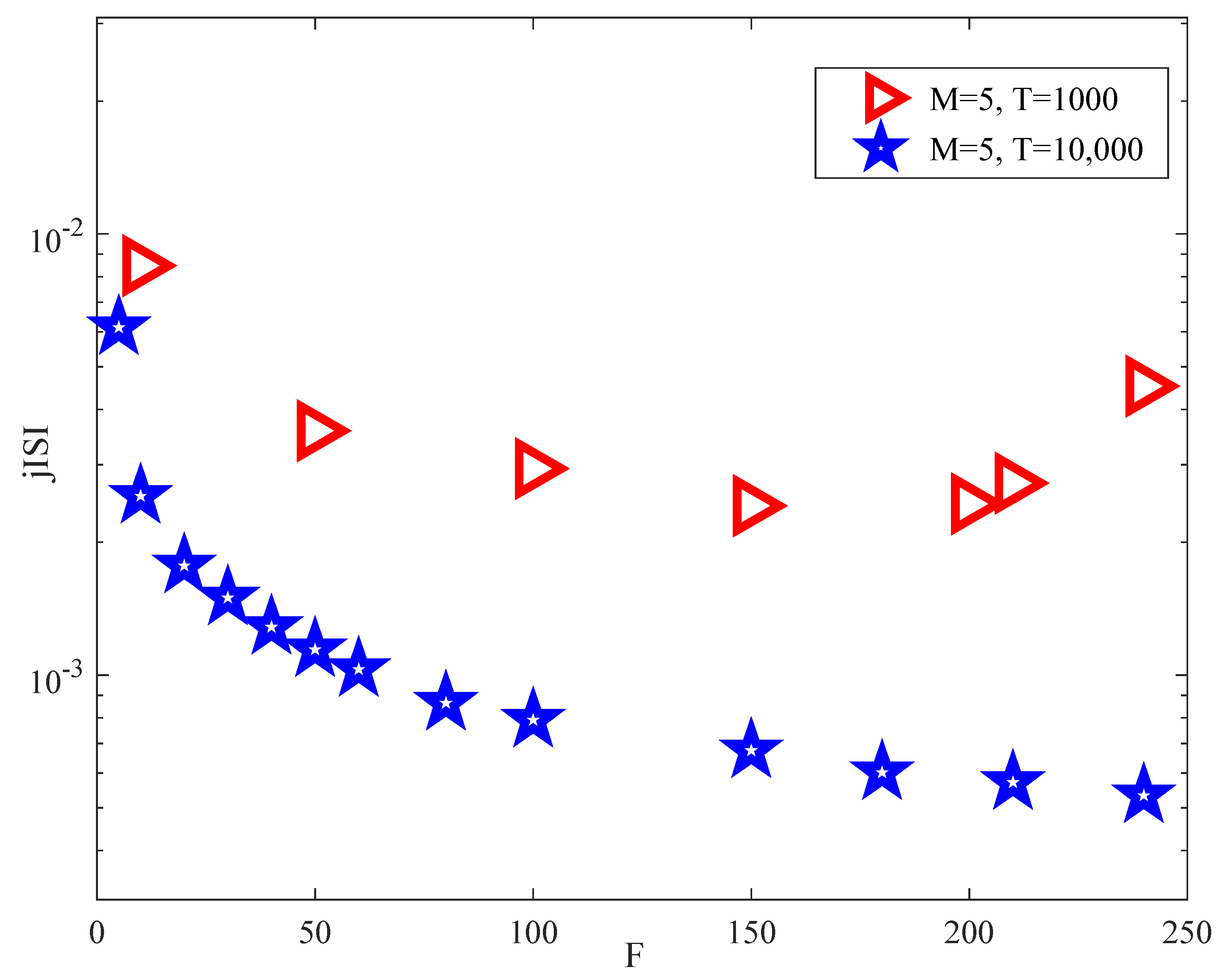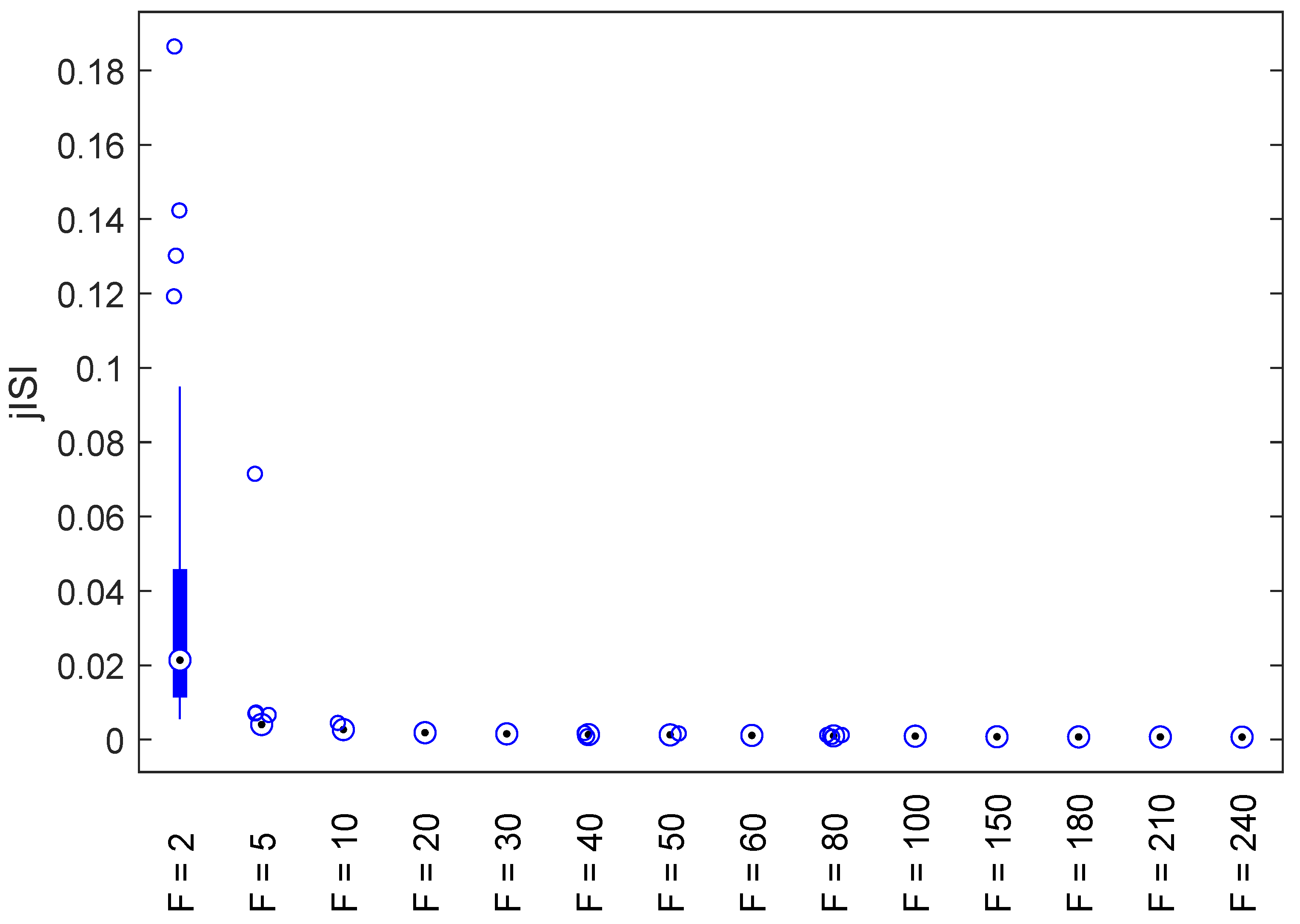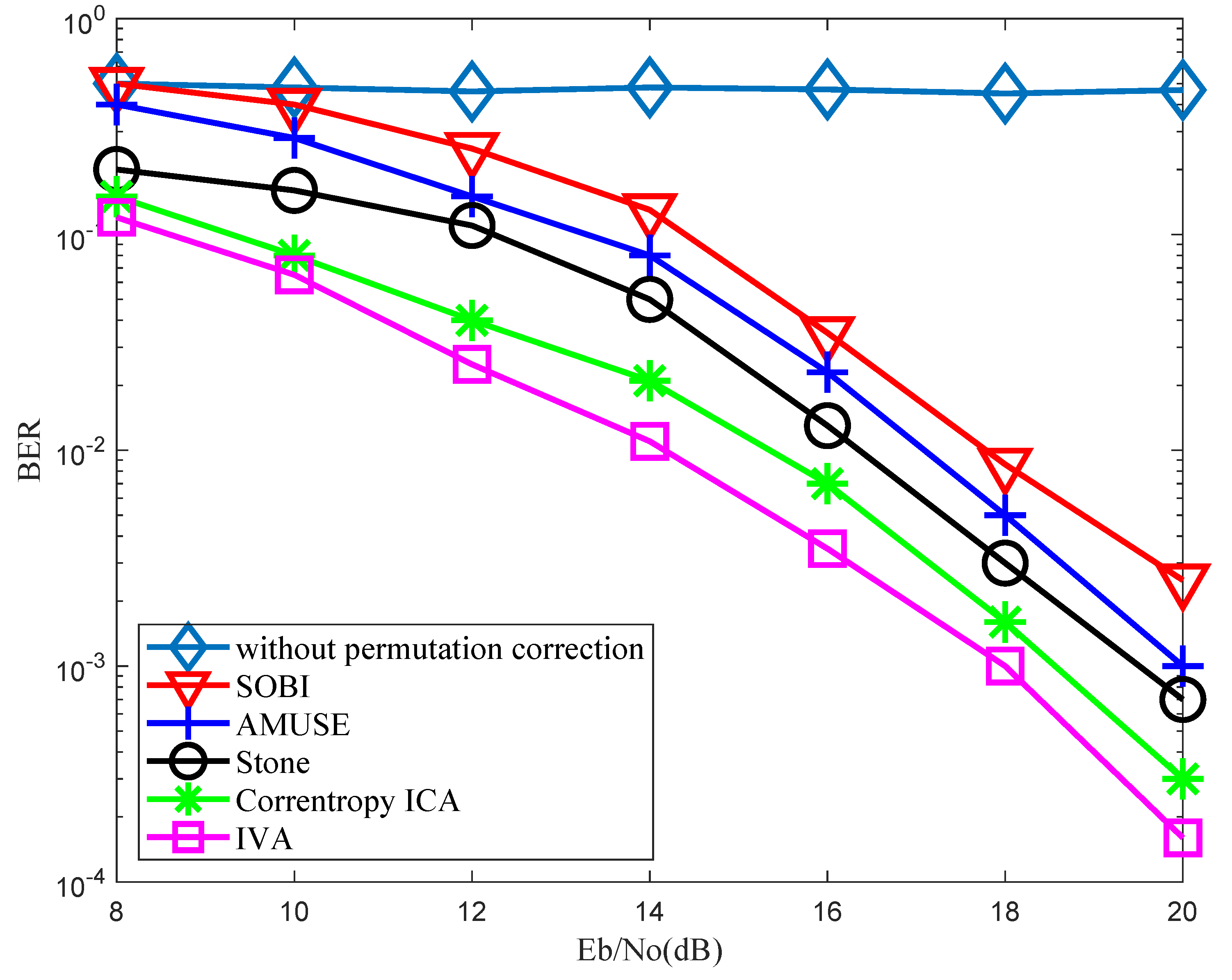1. Introduction
With the sharply exploding advent of wireless transmission data, the spectrum band resources have become increasingly urgent and congested. A multitude of mixed signals are widespread existing in wireless receivers. This phenomenon has resulted in the difficulties of the conventional receiving processing technology. The prior information of wireless channel is also especially hard to acquire. If the channel state information (CSI) is unknown, and only the received mixture signals can be utilized, the blind adaptive processing will be a promising scheme for source recovery. Thus far, this processing mechanism has received great attention and will be a promising scheme for future intelligent and green communications, known as latent data analysis or unsupervised learning methods [
1,
2].
Blind source separation (BSS) is a typical latent data analysis method, which has solid theoretical foundations and extensive potential applications [
1,
3,
4]. It can achieve the latent source separation only from the received mixture signals, depending on the statistical features of source signals. One of the representative BSS methods is relying on the independent principle of source to implement separating assignment, i.e., independent component analysis (ICA). To the best of our knowledge, ICA-assisted wireless receiving processing has attracted remarkable attention from home and abroad. There are many scholars engaged in investigating these interesting areas [
1,
3,
4,
5,
6,
7,
8,
9,
10,
11,
12,
13,
14,
15,
16,
17]. These typical related works are given below for discussion.
In the wireless communication systems, the received signals model is always constructed as the instantaneous mixture of source signals and channel effects. Then, the ICA methods can be used for source signal separation or extraction. From the perspective of the processing mechanism, the time-domain ICA methods are the main detection tools, such as in [
6,
7]. The time-domain ICA-based detection schemes are for wireless receiving mixture modulation signals. However, in real applications, suffering the multipath fading channel effects, the wireless receiving model should be established as a convolutive mixture of source signals and channel factors. In this convolutive model, direct time-domain ICA methods suffer from severe computational complexity problems with low implementation efficiency.
To overcome the above-mentioned problem, the frequency-domain ICA (FDICA) is recommended for separating each frequency bin instantaneous mixture obtained from the time frequency transformation of convolutive mixtures [
5,
13,
14,
15,
16,
17]. FDICA independently carries out ICA separation, neglecting the relationship of each frequency bin dataset, which uses univariate source component for achieving source modeling. It has been extensively used in multiple input multiple output (MIMO) and MIMO–OFDM (multiple input multiple output–orthogonal frequency division multiplexing) detection [
13,
14,
15,
16,
17]. In reference [
13], the authors investigated FDICA-based impulse interference mitigation for MIMO-OFDM systems. In reference [
14], the authors proposed a blind channel estimation using correntropy FDICA for MIMO–OFDM systems. The authors in reference [
15] developed an FDICA-based decoding method for massive array antenna MIMO systems. In reference [
16,
17], the authors proposed an FDICA-based MIMO–OFDM receiver for green communication processing. However, FDICA confronts the random permutation ambiguity problem, which will lead to the difficulty of the source recovery. In processing, the random permutation correction must be used for the further source detection.
To solve the above-mentioned problems, this paper proposes an IVA detection receiver for blind deconvolving of wireless receiving mixture data. IVA is a generation of ICA, which can not only overcome random permutation problems, but also acquires performance enhancement due to using a multivariate source model instead of a univariate source model for constructing separation function [
18,
19,
20,
21,
22]. Experimental results and analysis corroborate the effectiveness and efficiency of the proposed IVA detection receiver.
The remainder of this paper is constructed as follows.
Section 2 discusses the system model and problem formulation.
Section 3 talks about the IVA detection receiver, including cost function formulation and optimization methods. Computational complexity and performance evaluation are discussed in
Section 4.
Section 5 conducts experiments for confirming the proposed method. Lastly, conclusions are obtained in
Section 6. The math notations are illustrated as follows. Scalars, vectors, and matrices are denoted by lowercase letters, lowercase boldface letters, and uppercase boldface letters, respectively. The uppercase superscripts
“T” and
“H” are used for transpose and hermite transpose, respectively, and “∗” denotes the convolutive operation.
2. System Model and Problem Formulation
In wireless communications, the source signals always transmit through frequency-selective fading channels. The received signals are the convolutive mixtures of source signals and channel effects. A typical system model with time-domain ICA detection receiver is illustrated in
Figure 1.
In
Figure 1, the transmitted source signals are denoted as
,
,
, and the received signals are represented as
,
,
.
M and
T are the numbers of source signals and sample length, respectively. The number of received signals equals that of source signals. The impulse response of channel from the transmitter
l to the receiver
m is
.
represents the circularly symmetrical complex Gaussian noise term. The time-convolutive mixture contaminated by noise can be described as
In practical applications, the convolutive mixture model is always generated from two propagation influences emerged in wireless fading channels. First, the source signals reach the different receivers with delays. Second, the source signals are transmitted through multipath fading channel.
In the time-convolutive mixture model, direct ICA blind separation processing is a difficult task with high computation complexity. Therefore, the time-domain model can be transformed as a multiple-frequency-domain instantaneous mixture through discrete short-time Fourier transform (STFT). The discrete STFT of the received signal
is denoted as
where
t is the frame number, and
f is the frequency bin,
. The window function
can be chosen as a rectangular window of length
L. The
F-point fast Fourier transform (FFT) is implemented over the windowed section of the
. The number of
F is set as larger than or equal to the window length
L, i.e.,
.
Similar to the previous Equation (
2), the
is expressed as the discrete STFT of the
. For the sake of simplification, the vector form of
and
is defined as
,
, and
, respectively. The corresponding matrix form is
,
and
. After this operation, the time-convolutive mixture will be converted into frequency-domain instantaneous mixtures:
Assume that the source signal
is zero-mean, complex-valued, non-Gaussian distributed, and statistically independent. In each frequency bin, the
also satisfies independent condition, which is proved in
Appendix A. Thus, the ICA assumptions are satisfied. Then the frequency-domain ICA is implemented in each frequency bin to separate the source signals
independently. Before the ICA, the whitening processing will be carried out firstly to reduce the noise effect and make the mixing matrices orthogonal. We implement the whitening processing independently in each frequency bin. Regarding the
fth frequency bin (
), the whitening operation is executed through the transform
, where
,
, and
is the
ith largest eigenvalue of the covariance matrix
,
is a
matrix constructed by the corresponding eigenvectors, and
is the variance of the noise. In practice, in order to estimate the noise variance, the number of receiver sensors is set as larger than that of the source signals. Thus, the noise variance can be estimated by averaging the difference in value of the smallest eigenvalue. The whitening operation can make the orthogonal property of the mixing matrices, i.e., it will satisfy the condition
.
Due to the inherent ambiguity problem of BSS, the independent ICA will give rise to the random permutation ambiguity problem. The convolutive mixture model with frequency-domain ICA detection receivers is shown in
Figure 2. It is not easy to solve, which will directly affect the following source recovery assignment.
3. IVA Detection Receiver
In the separation of mixture model, the ICA methods used for each frequency bin mixture data suffer from the random permutation problem. IVA can provide a natural solution to this issue by acquiring the inherent dependencies of the transmitted digital modulation signals. Therefore, it can solve the random permutation problem and implement the separation of sources for adaptive wireless receiving processing. Regarding the used independent mechanisms in ICA and IVA that have differences, as shown in
Figure 3, in IVA, the multivariate source vector is used to replace the univariate source component for modeling the source prior. The proposed IVA detection model is evolved from the conventional FDICA scheme, which is demonstrated in
Figure 4. In the following, the fundamentals of IVA will be explained.
With regard to the model (
3), this problem is tackled through defining dependence between multiple components and developing a method for IVA directly. Without loss of generality, the noise effect term is not always considered for deriving the IVA method for simplicity. This consideration is reasonable due to that the whitening processing will be used for removing the noise effect in the process of before IVA, which is similar to that of the existing ICA processing.
According to the previous model (
3), frequency bin datasets containing samples are formed from linear mixtures of independent latent sources,
where each frequency bin dataset
,
is a linear instantaneous mixture of
M independent sources.
The invertible mixing matrices
are to be estimated as unknown complex-valued matrix.
is the latent random complex-valued source vector of source matrix
, in which superscript
T denotes transpose operations. In the IVA data model, the source components in each dataset are assumed to be independent statistically, while in different datasets they have dependence connections. For formulating the dependence function across source components, the source component vector (SCV) can be collected by vertically concatenating the nth source from every dataset as follows:
The related source component matrix (SCM) is illustrated in
Figure 5 through concatenating the
mth row of each
. The SCVs are mutual statistically independent random vectors. The probability distribution function (PDF) of the concatenated source vector can be denoted as
.
The purpose of IVA is to seek
F separation matrices and the corresponding source vector estimation for each dataset, with the
fth estimations indicated as
. The source estimations are represented as
The estimation of the mth component from the fth dataset is denoted as , in which superscript H indicates the complex conjugate transpose, is the complex conjugate operator, is the mth column of , and is the element in the nth row and lth column of . The estimation of the mth SCV is described as . The mixing matrices mean the influence of wireless channels, which are potentially distinct for each dataset and are not necessarily related.
The cost function of IVA is obtained in the same formation as that of ICA, i.e., minimum mutual information (MMI) or maximum likelihood (ML) [
20,
21]. Compared with just estimating single separation matrices in ICA, the purpose of IVA requires to estimate
F separation matrices
to achieve source estimations.
3.1. Cost Function for IVA
The fundamental principle of IVA is to maximize the independence of all of SCVs, which can be acquired through minimizing the mutual information among the source component vectors. A set of separation matrices needs to be estimated that can be organized as a three-dimensional array or tensor
. The essential cost function of IVA based on the MMI principle is represented as [
18,
19,
20,
21,
22]:
in which
illustrates the differential entropy of the estimated
mth SCV, and the term
denotes a constant parameter
, where it is regarded as a constant in the subsequent optimization implementation. Particularly noteworthy is that the entropy of a linear invertible transformation,
, in the complex domain is given by
, and the determinant of a block diagonal matrix is a product of the determinants of the individual blocks. The
is a regularization term that penalizes separation matrices with small determinants and restricts separation matrices to be unitary when the penalty term becomes fixed.
By definition,
, where
is the mutual information within the mth SCV, which sheds light on the dependence within components of an SCV. Thus, Equation (
7) can be obtained as follows after replacing of
:
The previous mathematical description expresses that minimizing the cost function is to simultaneously maximize the mutual information within individual SCVs and minimize the entropy of all components. It is essential to point out that the mutual information in the IVA cost function gives an insight for solving the random permutation ambiguity across multiple datasets.
3.2. Optimization Methods for IVA
According to [
21],
is defined to be a unit length vector such that
, where
is the
matrix formed by removing the
mth column of the separation matrix
. Then, it can be computed as
where
. Clearly, the value of
is independent of
. The calculation of
can be computed using an extension of the efficient real-valued recursive method explained in [
20] to complex domain processing. By replacing Equation (
9) in Equation (
7), we obtain
where we note that
is independent of
for
, yielding
then, IVA using vector gradient descent can be denoted as
in which
denotes the nonnegative step size. The IVA cost function derivative is derived with respect to the complex conjugate of
as
where
shows the expectation operator. Applying the complex derivative rules of Wirtinger calculus, it yields
and
Combining with the previous derived three gradients and assuming that
we can obtain
4. Computational Complexity and Performance Evaluation
The time-domain ICA method is only theoretically feasible. However, the time-domain methods are computationally complex because of the convolutive mixture mechanism. It is not realizable to use time-domain ICA, owing to the computational need.
After time-frequency processing, it is computationally efficient to implement separation work in each frequency bin, named FDICA. This method requires F times independent ICA work for source separation, which has roughly the complexity order of . In contrast with ICA, the IVA requires that of . It is noticeable that the sampling length T is far larger than the number of source components M and frequency bins F. Therefore, they have roughly similar computational complexity. Moreover, the FDICA needs the permutation correction processing that also will lead to some computation complexities.
In addition, due to that the inherent random permutation problem existed in the FDICA method, the permutation correction must be used for further source recovery. Otherwise, the performance will be lost severely. In IVA, the random permutation problem can be overcome. Moreover, the multivariate source models are utilized for source separation; this will be better than the independently used univariate source model for realizing the digital modulation signal model. In the next section, the simulation experiment will be conducted for performance comparison; this will confirm the effectiveness of the investigated IVA-based detection method.
5. Simulation Results and Analysis
To verify the effectiveness of the proposed IVA detection receiver, we conduct computer simulations for performance analysis. Before the application of IVA to convolutive mixtures, IVA experiments are implemented for helping set the appropriate algorithm parameters to wireless receiving detection application. Then, four different FDICA methods and the proposed IVA detection method are implemented for performance comparison in a convolutive mixture application. The joint inter-symbol interference (
jISI) is used to as performance index. The
jISI is derived from the conventional normalized inter-symbol interference (
ISI) and is used to analyze performance, i.e,
where
. The
ISI can be extended to obtain the joint
ISI, i.e.,
, and
is the absolute value of
.
The metric jISI measures the consistency of SCV estimation among datasets. The lower jISI means the better separation performance. In addition, BER performance metric is also used to evaluate the different detection methods for convolutive mixture separation in wireless receiving processing.
In IVA, the complex multivariate generalized Gaussian (MGGD) distribution [
20,
21]-based IVA is used to performance evaluation. The number is set as 5, and the sample length is 1000 vs. 10,000. The MGGD used is to generate the sub-Gaussian distribution-based SCV for simulating sub-Gaussian communication signals. The mth SCV is a zero-mean with
F dimensional sub-Gaussian random vector. The different SCV structure is random correlation structure. In addition, we mainly consider the gradient iteration. We know the Newton manner is faster but with high complexity and maybe non-convergence. Therefore, the gradient is suggested in this paper. The random correlation covariance structure is defined as
, where the elements of
are from the standard complex-valued normal distribution.
The experimental results are shown in
Figure 6, which illustrates that IVA with the long sample length is better than that of the short sample length. In
Figure 7, the statistical analysis of jISI for different
F value is given for illustrating that the proper
F values can be set as for the following joint analysis, such as
.
For the purpose of confirming the IVA detection performance for a real communication application scheme, the following experiment is carried out. The simulation parameters are set as follows. The channel is chosen as a slowly-varying frequency-selective fading channel. This means that the channel impulse response changes slowly with the transmitted symbol period. This mixture mechanism can be described as a static mixture. The third-order convolutive mixture systems with the Gaussian distribution coefficients are used for simulation. The source signals are uniformly distributed independent differential quadrature phase shift keying (DQPSK). The number of source and received signals is 5. The sample length of the received signals is 10,000. The length of the rectangular window is 3. The points of the FFT are 16. In order to highlight the proposed IVA, different representative ICA methods are used to make performance comparisons. The simulation results are demonstrated in
Figure 8.
According to the above-mentioned parameters, we simulate the IVA and four FDICA methods for performance comparison. The averaged bit error rate (BER) of the data sequence with regard to the transmission data is evaluated. In FDICA, the permutation correction scheme is from the reference [
14]. In order to highlight the performance improvement, the third FDICA method without permutation corrections is also given. Simulation results are shown in
Figure 8, which verify the effectiveness of applying the IVA method. The proposed IVA scheme acquires the improved BER performance.
6. Conclusions
The received wireless signals are always the convolutive mixture of the latent source signals in the unknown condition of slow frequency-selective fading channels. The main work of this paper is to propose an IVA-detection-based blind separation of convolutive signals. IVA is beneficial for conquering permutation ambiguity encountered in the conventional frequency-domain ICA model. In addition, the multivariate source models are jointly used in IVA for performance enhancement. Simulation results show that the performance of the proposed IVA detection method is better than that of the conventional FDICA detection method. In the future work, the robust IVA method is strongly recommended to be investigated for overcoming different environmental noise impact as well as dynamic channel condition impairment.
Author Contributions
Conceptualization, Z.L.; methodology, Z.L. and R.G.; software, R.G.; validation, Z.L., R.G. and C.L.; formal analysis, Z.L.; investigation, Z.L.; writing—original draft preparation, Z.L.; writing—review and editing, Z.L., R.G. and C.L.; funding acquisition, Z.L. All authors have read and agreed to the published version of the manuscript.
Funding
This work was supported in part by Sichuan Science and Technology Program under Grant 2020JDJQ0061, 2021YFG0099, in part by the National Natural Science Foundation of China under Grant 61801319, in part by Innovation Fund of Chinese Universities under Grant 2020HYA04001, in part by the Sichuan University of Science and Engineering Talent Introduction Project under Grant 2020RC33, and in part by the Artificial Intelligence Key Laboratory of Sichuan Province Project under Grant 2021RZJ03 and 2021RZJ04.
Institutional Review Board Statement
Not applicable.
Informed Consent Statement
Not applicable.
Data Availability Statement
Not applicable.
Conflicts of Interest
The authors declare no conflict of interest.
Abbreviations
The following abbreviations are used in this manuscript:
| BER | Bit error rate |
| BSS | Blind source separation |
| DQPSK | Differential quadrature phase shift keying |
| FDICA | Frequency-domain independent component analysis |
| ICA | Independent component analysis |
| IVA | Independent vector analysis |
| MMI | Minimum mutual information |
| ML | Maximum likelihood |
| MIMO | Multiple input multiple output |
| OFDM | Orthogonal frequency division multiplexing |
Appendix A
According to the theorem from [
23], if the two random variables
x and
y are independent, then the functions of these random variables
and
are also independent.
The previous theorem shows that functions of independent random variables are also independent. In the frequency bin model, the sources
are statistically independent so that their discrete STFT,
are linear functions of the
as
Therefore, these frequency components are also statistically independent in each frequency bin.
References
- Luo, Z.; Li, C.; Zhu, L. A comprehensive survey on blind source separation for wireless adaptive processing: Principles, perspectives, challenges and new research directions. IEEE Access 2018, 6, 66685–66708. [Google Scholar] [CrossRef]
- Rekkas, V.P.; Sotiroudis, S.; Sarigiannidis, P.; Wan, S.; Karagiannidis, G.K.; Goudos, S.K. Machine Learning in Beyond 5G/6G Networks—State-of-the-Art and Future Trends. Electronics 2021, 10, 2786. [Google Scholar] [CrossRef]
- Luo, Z.; Zhu, L.; Li, C. Independent component analysis based blind adaptive interference reduction and symbol recovery for OFDM systems. Chin. Commun. 2016, 13, 41–54. [Google Scholar]
- Kharbech, S.; Simon, E.P.; Belazi, A.; Xiang, W. Denoising higher-order moments for blind digital modulation identification in multiple-antenna systems. IEEE Wirel. Commun. Lett. 2020, 9, 765–769. [Google Scholar] [CrossRef]
- Liu, Y. Frequency Domain Independent Component Analysis Applied to Wireless Communications over Frequency-Selective. Channels.Ph.D. Thesis, University of Central Florida, Orlando, FL, USA, 2005. [Google Scholar]
- Luo, Z.; Zhu, L. A charrelation matrix-based blind adaptive detector for DS-CDMA systems. Sensors 2015, 15, 20152–20168. [Google Scholar] [CrossRef] [PubMed]
- Luo, Z.; Chen, Y.; Jing, C. An Enhanced ICA Based on Minimum BER Criterion and Nesterov-Accelerated Adaptive Moment Estimation. Wirel. Pers. Commun. 2021, 122, 3913–3929. [Google Scholar] [CrossRef]
- Li, C.Y.; Zhu, L.; Luo, Z.; Zhang, Z.; Yang, Y. Effective methods and performance analysis on data transmission security with blind source separation in space-based AIS. China Commun. 2022, 19, 154–165. [Google Scholar] [CrossRef]
- Lü, X. Study of ICA Based Blind Channel Identification in MIMO OFDM Systems. Ph.D. Thesis, Lanzhou University, Lanzhou, China, 2006. [Google Scholar]
- Jiang, C. Blind Channel Estimation and Equalization Based on ICA in MIMO-OFDM System. Master’s Thesis, Jilin University, Changchun, China, 2009. [Google Scholar]
- Nandi, A.K.; Gao, J.; Zhu, X. Independent component analysis-an innovative technique for wireless MIMO OFDM systems. In Proceedings of the 2009 4th International Conference on Computers and Devices for Communication (CODEC), Kolkata, India, 14–16 December 2009; pp. 1–8. [Google Scholar]
- Zheng, S. Study on the Technology of the ICA-Based Blind MIMO-OFDM Receivers. Master’s Thesis, Ningbo University, Zhejiang, China, 2012. [Google Scholar]
- Cui, Y. Impulse Interference Mitigation Research Based on ICA for MIMO-OFDM System. Master’s Thesis, Civil Aviation University of China, Tianjin, China, 2015. [Google Scholar]
- Alaghbari, K.A.; Siong, L.H.; Tan, A.W. Robust correntropy ICA based blind channel estimation for MIMO-OFDM systems. COMPEL Int. J. Comput. Math. Electr. Electron. Eng. 2015, 34, 962–978. [Google Scholar] [CrossRef]
- Yan, B. Decoding Method Based on ICA for Massive Array-Antenna MIMO Systems. Master’s Thesis, Hangzhou Electronic Science and Technology University, Zhejiang, China, 2017. [Google Scholar]
- Khosravy, M.; Gupta, N.; Patel, N.; Dey, N.; Nitta, N.; Babaguchi, N. Probabilistic Stone’s Blind Source Separation with application to channel estimation and multi-node identification in MIMO IoT green communication and multimedia systems. Comput. Commun. 2020, 157, 423–433. [Google Scholar] [CrossRef]
- Khosravy, M.; Gupta, N.; Dey, N.; Ger, P.M. Smart green ocean underwater IoT network by ICA-based acoustic blind MIMO OFDM transceiver. Earth Sci. Inf. 2021, 14, 1073–1081. [Google Scholar] [CrossRef]
- Nakatani, T.; Ikeshita, R.; Kinoshita, K.; Sawada, H.; Kamo, N.; Araki, S. Switching Independent Vector Analysis and Its Extension to Blind and Spatially Guided Convolutional Beamforming Algorithms. IEEE/ACM Trans. Audio Speech Lang. Process. 2022, 30, 1032–1047. [Google Scholar] [CrossRef]
- Brendel, A.; Haubner, T.; Kellermann, W. A unified probabilistic view on spatially informed source separation and extraction based on independent vector analysis. IEEE Trans. Signal Process. 2020, 68, 3545–3558. [Google Scholar] [CrossRef]
- Anderson, M.; Adali, T.; Li, X.-L. Joint blind source separation with multivariate Gaussian model: Algorithms and performance analysis. IEEE Trans. Signal Process. 2012, 60, 1672–1683. [Google Scholar] [CrossRef]
- Anderson, M.; Li, X.-L.; Adalı, T. Complex-valued independent vector analysis: Application to multivariate Gaussian model. Signal Process. 2012, 92, 1821–1831. [Google Scholar] [CrossRef]
- Damasceno, L.P.; Cavalcante, C.C.; Adalı, T.; Boukouvalas, Z. Independent Vector Analysis Using Semi-Parametric Density Estimation via Multivariate Entropy Maximization. In Proceedings of the ICASSP 2021—2021 IEEE International Conference on Acoustics, Speech and Signal Processing (ICASSP), Toronto, ON, Canada, 6–11 June 2021; pp. 3715–3719. [Google Scholar]
- Papoulis, A.; Pillai, S.U. Probability, Random Variables, and Stochastic Processes, 4th ed.; McGraw-Hill: New York, NY, USA, 2002. [Google Scholar]
| Publisher’s Note: MDPI stays neutral with regard to jurisdictional claims in published maps and institutional affiliations. |
© 2022 by the authors. Licensee MDPI, Basel, Switzerland. This article is an open access article distributed under the terms and conditions of the Creative Commons Attribution (CC BY) license (https://creativecommons.org/licenses/by/4.0/).
